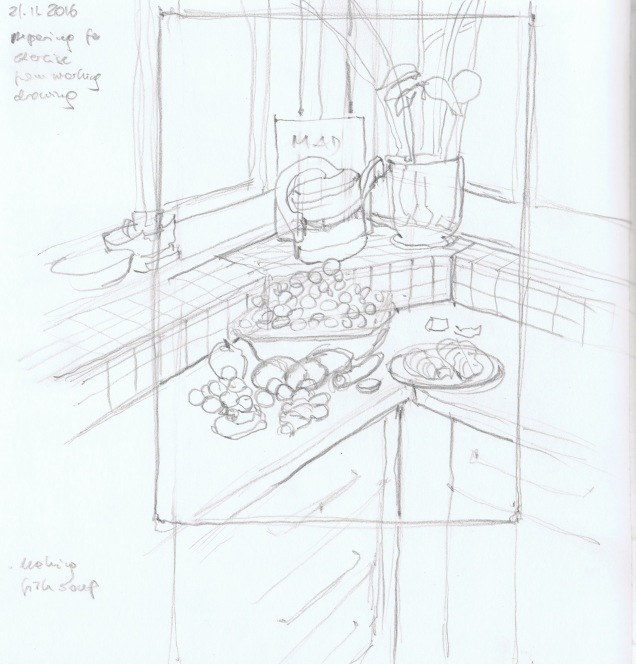Updated on 23 March 2017 (Harvard referencing).
20 November 2016. Having to work high speed to finish Part 4 of the course in time. The requirements set out for the exercises in this project, luckily, are not very different from what I have been doing all along in one way or another, often combining a number of helping techniques (thumbnail drawings, larger linear, tonal and colour sketches, photographs, and more recently painting from memory or inventing an imaginary setting). So, what I might do is shift towards a more complex composition. There is a crowded corner in our kitchen at the moment with lots of beautifully coloured fruit and nuts collected by the squirrel in our family, i.e. my husband, which I would like to go for here and lay the main emphasis on painting from memory again. This latter method I have come to enjoy very much recently. It opens up a whole new world of compositional freedom together with ample opportunity to make a mess from which to learn.
22 November 2016. Here are my three sketches, the first two of which – pencil line and charcoal tonal sketch – I made while cooking a fish soup for my son following the “Modified Atkins Diet”. My intention was to take what was there on the worktop and see whether I would be able to develop it into something worth looking at (Fig.1 -3).



To be honest I was quite pleasantly surprised at the outcome of the colour sketch (especially the fish on the plate, which consists of nothing but a few semi-transparent brushstrokes) and will be trying to loosely follow this in my final painting.
Here is the sequence of stages through the final painting (Fig. 4-7):


I very much like the strange effect of mixed dilute paint separating into its component colours while drying on the smooth dry layer underneath:

In the picture above on the plate with the fish the behaviour of the dilute paint can be observed while in the process of drying. There is no way in which the paint can be influenced during that stage. It is possible, however, to paint over a such layer when dry with paint straight from the tube – see the effect on the fish in the final painting below (Fig. 7):

And here three details from the finished work (Fig. 8-10):



24 November 2016. Answers to the questions in the study guide:
- I think that the combination of first investigating the subject by direct observation, followed by a linear, a tonal and a colour sketch provided a great deal of familiarity with the arrangement and lighting conditions that most of the actual painting developed without reference to the sketches. There was no additional information I would have required.
- There was noticeably more freedom regarding the process of painting without direct reference to the setup (it was irreversibly gone by the time of painting, most of it having been cooked and eaten). I noticed that I was a lot more relaxed than usual and I did not mind at all reconstructing something from my memory that may not have been there in reality. This effect allowed me to produce a composition that feels “whole” in setup, choice of colour and style.
- Overall I think that the approach worked quite well. It was the first time that I managed to maintain, roughly, the same techniques (apart maybe from the fish, which was better in the colour sketch). I like the brilliance of the chosen colours and the weird effect produced by using dilute paint, although I am aware that the latter is a bit rough in places. More importantly I feel that I am getting somewhere at last.
4 thoughts on “Part 4, project 5, exercise 1: Working from drawings and photographs – painting from a working drawing”